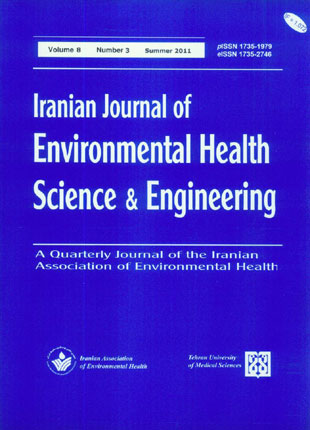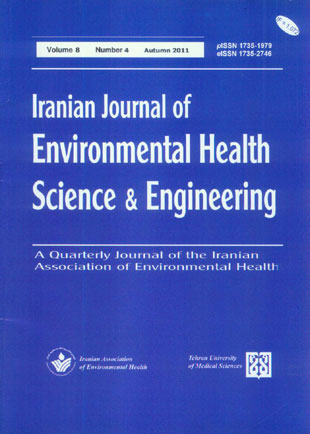فهرست مطالب

Iranian Journal of Environmental Health Science and Engineering
Volume:8 Issue: 3, Summer 2011
- تاریخ انتشار: 1390/07/24
- تعداد عناوین: 11
-
-
Page 189In this study the efficiency of magnetic nanoparticles for removal of trivalent arsenic from synthetic industrial wastewater was evaluated. The nanoparticles was prepared by sol-gel method and characterized by X-ray methods including XRD, XRF, and SEM, and vibrating sample magnetometer (VSM). The results showed that synthesized nanoparticles were in the size range of 40-300 nm, purity of about 90%, and magnetization of nanoparticles was 36.5emu/g. In initial conditions including: pH=7, As(III) concentration of 10 mg/L, nanomagnetite concentration of 1g/L, shaking speed of 250 rpm and 20 minute retention time, 82% of As (III) was removed. Competition from common coexisting ions such as Na+, Ni2+, Cu2+, SO42-, and Cl- was ignorable but for NO3- was significant. The adsorption data of magnetite nanoparticles fit well with Freundlich isotherm equations. The adsorption capacity of the Fe3O4 for As (III) at pH=7 was obtained as 23.8 mg/g. It was concluded that magnetite nanoparticles have considerable potential in removal of As(III) from synthetic industrial wastewaters.
-
Page 201Di-(2-Ethylhexyl) phthalate (DEHP) belongs to the class of phthalate esters and is used as an additive in many products including plastics, paints and inks or as a solvent in industrial formulations. The degradation of DEHP in aqueous solution using oxidative Fenton reaction (H2O2/Fe2+) was carried out in this study. It was found that H2O2 concentration, Fe2+ concentration, and pH were the three main factors that could significantly influence the degradation rates of DEHP. The highest degradation percentage (85.6 %) of DEHP was observed within 60 min at pH 3 in H2O2/Fe2+ system. The results of our study suggested that the concentration with 90 mg/L H2O2, 5 mg/L Fe2+, and 20 mg/L DEHP in the solution at pH 3 were the optimal conditions. The optimized reaction parameters were preceded for treatment of real wastewater obtained from a petrochemical plant.
-
Page 207In this research, possibility of reducing excess sludge production in wastewater treatment was investigated using a combined anaerobic and aerobic submerged biological filter in a pilot scale. The physical model designed, erected and operated consisted of two pipes of PVC type with 147mm and 237mm diameter used as aerobic and anaerobic filters, respectively. The effective height of porous media in these filters was 70cm. Two filters were connected to eachother in a series form and the resulted system was loaded using synthetic wastewater based on sucrose in the range of 1.91 to 30.61 kg/m3 for anaerobic filter and 1.133 to 53.017 kg/m3 for aerobic filter. For similar loadings, the aerobic filter showed efficiency of 1.8 times that of anaerobic filter in removal of soluble COD. Return of 100% flow from the aerobic filter to the anaerobic filter for 30kg/m3.d of organic loading increased the efficiencies of the anaerobic filter, the aerobic filter and the combined system as 17%, 14% and 15%, respectively and the effect of the return of the flow was more pronounced in smaller hydraulic retention times and larger loadings. 100% return of the flow reduced the yield coefficient for the whole system to 0.037 for 53 kg/m3 loading which is a suitable value with regard to the scheme and no use of chemical materials such as chlorine and ozone. This coefficient reached a value as small as 0.007 in common loadings (7.5kg/m3) for 100% return of the flow which is very close to zero. So, this method could be considered as a complete biological treatment with low excess sludge and could be assessed in full scale.
-
Page 219Thiol rice straw (TRS) was prepared by esterifying thioglycolic acid onto rice straw in the medium of acetic anhydride and acetic acid with sulfuric acid as catalyst. The sorption of lead (Pb) on TRS from aqueous solution was subsequently investigated. The batch experiments showed that Pb removal was dependent on initial pH, sorbent dose, Pb concentration, contact time, and temperature. The maximum value of Pb removal appeared at pH 5. For 100 mg/L of Pb solution, a removal ratio of greater than 98% could be achieved with 2.0 g/L or more of TRS. The isothermal data of Pb sorption conformed well to the Langmuir model, and the maximum sorption capacity (Qm) of TRS for Pb was 104.17 mg/g. The equilibrium of Pb removal was reached within 120 min. The Pb removal process could be described by the pseudo-first-order kinetic model. The thermodynamic study indicated that the Pb removal process was spontaneous and endothermic.
-
Page 227Because conventional wastewater treatment of effluent containing anthraquinone dye causes notable environmental problems, it is important to find effective alternative methods for dye removal. This study evaluated the efficacy of ozonation for dye removal and Chemical Oxygen Demand reduction and identified optimal operational conditions for parameters such as pH, contact time and concentration of C.I. Reactive Blue 29 dye in a semi-batch reactor. Values of pH between 3 and 11 and contact times between 15 and 120 minutes were investigated. Dye concentrations were based on the American Dye Manufacture Institute standards and ranged from 1000 to 5000. Although results showed that Chemical Oxygen Demand removal by ozone alone was not very efficient (58%), ozonation proved to be an efficient method for decolorizing Reactive Blue 29 (96%). pH was found to significantly influence the effectiveness of Chemical Oxygen Demand removal, and optimal pH conditions (95% confidence interval) were between 9 and 11. For decolorization, pH adjustment was not necessary. Degradation and decolorization of dye were found to be strongly influenced by the contact time, optimal conditions (95% confidence interval) for degradation and decolorization were 60 and 30 minutes, respectively. The optimal dye concentration was 1000 American Dye Manufacture Institute.
-
Page 235The main objective of present work was to compare the overall performances of "moving-bed" and "conventional" sequencing batch reactor. For this purpose, different experimental parameters including COD and dye concentration, turbidity, MLSS concentration, MLVSS/MLSS ratio, sludge volume index (SVI) and Oxidation-Reduction Potential (ORP) were calculated. One conventional sequencing batch reactor and three moving-bed sequencing batch reactors (MB-SBR) were operated in this study. Each MB-SBR was equipped with a type of moving biofilm carrier. The results of dye, COD and turbidity analysis showed that there were no significant differences between the moving-bed and conventional sequencing batch reactors in the matters of effluent quality. A higher fluctuation of MLSS concentration and also higher SVI were observed in moving-bed compared to that of the conventional sequencing batch reactor. Higher ORP values which mean higher oxidation potential were measured in the reactors equipped with the moving carriers in comparison with those measured in the conventional sequencing batch reactor.
-
Page 255Activated sludge flow rheology is a very complicated phenomenon. Studies related to activated sludge tend to classify sludge as non-Newtonian fluid. Until now, several theories have been built to describe the complex behavior of activated sludge with varying degrees of success. In this article, seven different models for viscosity of non-Newtonian fluids (i.e., Power law, Bingham plastic, Herschel-Bulkley, Casson, Sisko, Carreau and Cross) were considered to evaluate their predictive capability of apparent viscosity of activated sludge. Results showed that although evaluating the constants in the four-parameter models is difficult, they provide the best prediction of viscosity in the whole range of shear rates for activated sludge. For easier prediction of viscosity at different mixed liquor suspended solids (2.74-31g/L), temperature (15-25°C) and shear rate (1-1000/s), simple correlations were proposed. Comparing the results with the experimental data revealed that the proposed correlations are in good agreement with real apparent viscosities.
-
Page 265In this study titanium dioxide cluster was incorporated onto NaY zeolite and characterized with X-Ray diffractometer and X-ray spectroscopy. These composites have many advantages such as high stability and high porosity. The adsorption behavior of methylene blue was investigated for NaY zeolite and TiO2/NaY zeolite. The efficiency of time, pH, temperature and initial concentration of methylene blue (MB) on removal effect of methylene blue was investigated by UV-Vis spectroscopy. And, the optimum conditions were determined 8h time, basic pH and high initial concentrations of methylene blue and absorbent. With increasing of temperature, the removal efficiency of NaY zeolite and TiO2/NaY increased. Results showed that 92% and 85% of methylene blue was absorbed by synthesized NaY zeolite and TiO2/zeolite, respectively. Adsorption isotherm as studied by fitting data to Langmuir and Freundlich isotherms models, showed monolayer adsorption and Langmuir equilibrium model to be more relevant.
-
Page 273Selecting the most suitable site for landfill can avoid any ecological and socio-economical effects. The increase in industrial and economical development along with the increase of population growth in Isfahan city generates tremendous amount of solid waste within the region. Factors such as the scarcity of land, life span of landfill, and environmental considerations warrant that the scientific and fundamental studies are carried in selecting the suitability of a landfill site. The analysis of spatial data and consideration of regulations, and accepted criteria are part of the important elements in the site selection. The present study presents a multi criteria evaluation method using GIS technique for landfill suitability site evaluation. The Analytic Hierarchy Process (AHP) was used for weighing the information layers. By using the fuzzy logic method (classification of suitable areas in the range of 0 to 255 byte scale) the superposing of the information layers related to topography, soil, water table, sensitive ecosystems, land use and geology maps was performed in the study. Only after omission of inappropriate areas, the suitability examination of the residue areas was accomplished. The application of the present method in Isfahan city shows approximately 5% of the south east and north east parts of the study area with the value of more than 220 byte scale, which are suitable for landfill establishment.
-
Page 280Pot culture experiments were carried out to study the effect of characterized municipal solid waste compost (MSWC) amendments (0, 50, 100, 250, 500, 750 and 1000 g) with garden soil (6 kg) on the growth and the yield of green gram (Vigna radiata (L) wilczek) and fenugreek (Trigonella foenum-graecum L.) as well as changes on soil quality. The growth and the yield of green gram and fenugreek were enhanced by MSWC application upto 500 g. Soil amended with > 500 g MSWC inhibited the plants biometric parameters neither with-significantly nor without-significantly suggest a possible toxic effects to both plants. No dosage effect was detected for total chlorophyll synthesized, except green gram grown in 1000 g of MSWC amendments. Compared with control, percentage of protein was increased significantly upto 250 g for green gram and 500 g for fenugreek. A significant reduction in percentage of carbohydrates was observed above 750 g of MSWC exposure for green gram and above 500 g for fenugreek. There was no specific trend and significant changes were observed in percentage of reducing sugars in both plants except green gram exposed to 50 g MSWC exposure. There was no significant difference in all plant yield parameters of both plants except fenugreek seed weight in 250 g MSWC amendment. Generally, chemical parameters of soil are improved by the addition of MSWC, after 90 d of experimental period.


